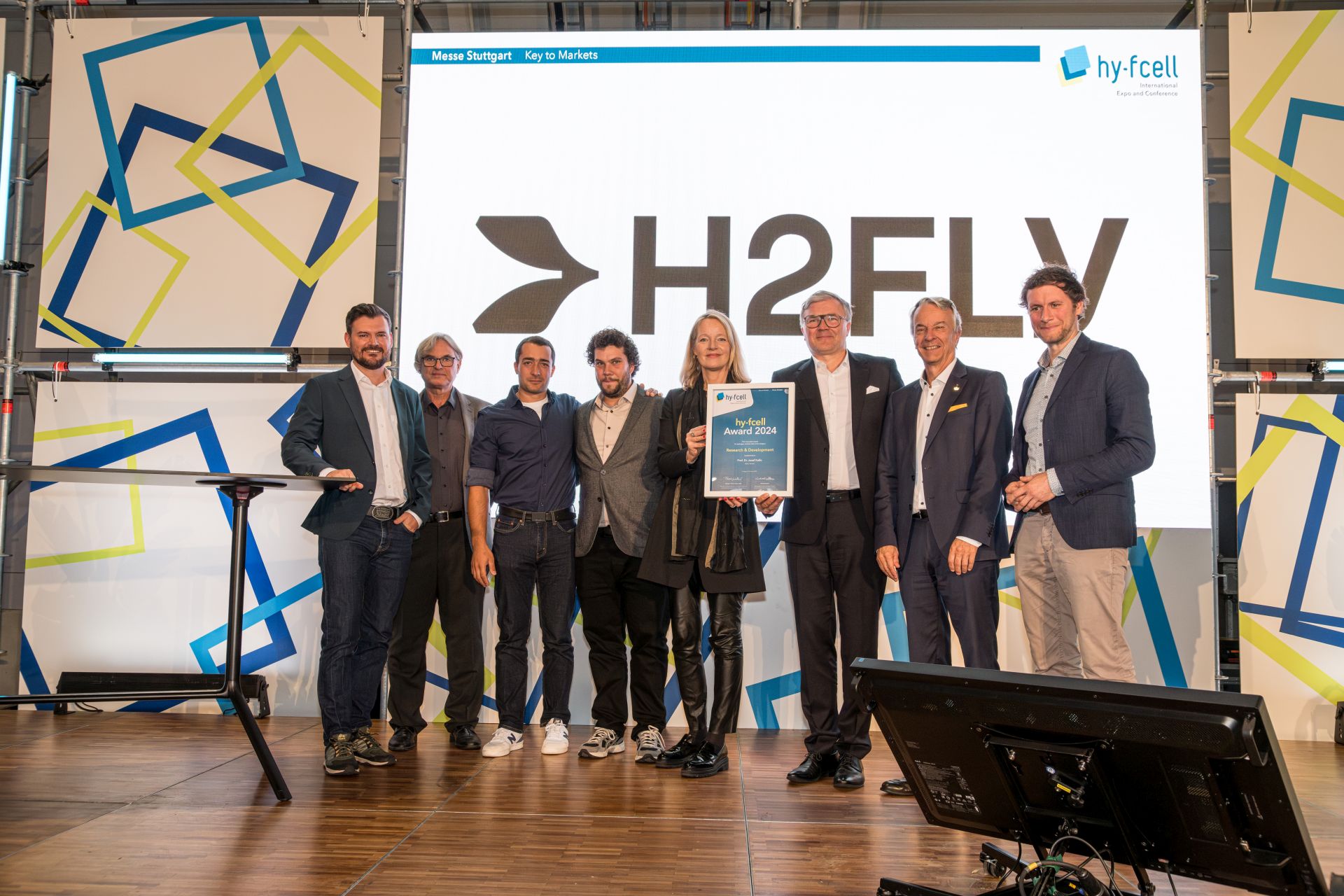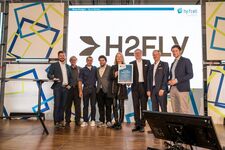H2FLY on progress and perspectives in hydrogen aviation
In the autumn of 2024, H2FLY received the coveted hy-fcell Award in the ‘Research & Development’ category. The Stuttgart company is considered a pioneer of zero-emission aviation and recently made international waves with its hydrogen-powered HY4 aircraft. With the 2024 award ceremony six months behind us and only 6 months to go before the next hy-fcell event, Dr. Josef Kallo, CEO of H2FLY, has shared some fascinating insights in the following interview. How has the company grown since receiving the award? What technological milestones have been reached – and when will the product be commercially available?
Your HY4 aircraft has shown that hydrogen-powered aviation is possible. What key milestones were achieved when creating this technology?
One of the first key events was the maiden flight of the HY4 in September 2016 at Stuttgart Airport. For the first time, we were able to demonstrate that a four-seater passenger plane, powered by hydrogen fuel-cell technology, could be operated with zero emissions and very low noise – a world-first at that time.
Another milestone was the first cross-country flight from Stuttgart to Friedrichshafen in April 2022. With this flight, we not only proved that hydrogen-power was also a safe option over longer distances but also set a new world record altitude of over 7,200 feet (approx. 2,200 metres) for aircraft in this technology category.
In September 2023, we then finally succeeded in operating a manned aircraft using liquid hydrogen. The use of cryogenic hydrogen, hydrogen in its liquid form, opened up entirely new range potential and represented a decisive step towards a more marketable product. During a test flight campaign, we were able to double the range of our HY4 test aircraft from 750 km to 1,500 km.
Another important phase involved the development and provision of a fuel cell system for the demonstrator air taxi from Joby Aviation, which was able to cover a distance of more than 800 km. This successful demonstration further emphasised the potential of our technology for the future of regional air mobility – without having to use any conventional runways.
All of these successes have only been possible thanks to the close cooperation we enjoy with strong partners from the worlds of research, industry and politics – and, of course, our highly motivated team who work hard every day to ensure the future of climate-neutral aviation.
The aviation sector is under growing pressure to develop zero-emission drive systems. What role will hydrogen play in the future of aviation?
Hydrogen is playing a key role in improving the sustainability of the aviation industry. As a source of high-density energy, it offers the potential for achieving greater distances – particularly for regional transport.
The benefits are obvious: only water is produced when converting hydrogen to electricity using fuel cells – no CO₂ emissions, no relevant nitrogen oxide. This represents significant progress compared to the more conventional fuels.
While battery-powered drives are perfectly suited to short-haul flights, the integration of hydrogen-powered drives is considerably expanding the spectrum of application. The successful demonstration flights carried out last year show how this combination is broadening the scope of potential for electrical aviation to medium-range distances – and thus expanding overall the range of application for zero-emission aviation mobility.
Hydrogen fuel cells could play a key role in the decarbonisation of air travel. How do you view the market potential and what are the hurdles that need to be overcome?
With a share of approx. 3–5 percent of the global greenhouse gas emissions, the aviation industry is making a considerable contribution to climate change. Particularly worrying is that these emissions will continue to increase unless any decisive action is taken, as the industry is growing annually. There is thus considerable market potential for hydrogen-powered aircraft.
In order for this to be a success, there needs to be a massive expansion of renewable energies for the production of green hydrogen. Only when hydrogen is produced renewably can we speak of climate-neutral air travel – and there is currently not enough capacity to achieve this.
Airport infrastructure also needs to be gradually built up – starting with modular units. At the same time, we are further developing and optimising our fuel cell and tank systems in order to create a marketable product that meets all certification requirements for safety, reliability and performance.
Our previous demonstration flights have shown that the technology is basically ready to be used. It is now a case of developing the framework for its commercial operation – together with those in industry, authorities and politics.
You are currently working on the next generation of your hydrogen fuel-cell drive. In terms of the technology, what are the next steps?
We are focusing on increasing power density and reducing the weight of the overall system. In order to be able to achieve these goals, we are increasingly developing our own components, which are optimally adapted to aviation requirements.
You are already collaborating with renowned partners such as Deutsche Aircraft. What role do your partnerships play in scaling the technology?
Partnerships are essential. We contribute fuel cell expertise, while our partners provide valuable knowledge from other areas, real-world application scenarios or access to markets. This enables us to optimally adapt our technology to the requirements of the aviation industry.
Decarbonisation of the aviation industry is a cross-sectoral task. We need to work closely together in order to be able to achieve the ambitious climate targets and implement sustainable solutions. Partnerships are not simply part of our “strategy”, they are essential for our success.
The aviation industry is highly regulated. What regulatory hurdles are you facing – and how do you overcome them?
We take a proactive and cooperative approach, and we work closely with the aviation authorities to devise the appropriate, regulatory framework. This not only involves the safety of the fuel cells, but also the safe storage of liquid hydrogen on board and its integration into the aircraft structure.
We are gaining valuable insights from our demonstration flights and the experience of working with smaller aircraft, knowledge which is being invested in future guidelines and certification processes.
Your work was recognised with the hy-fcell Award in 2024. How has your company developed since then?
We have made great progress in several strategic areas since receiving the award. Particular emphasis has been placed on developing the next generation of our fuel cell system – with a focus on power density and weight reduction. The in-house development of critical components is of key importance here.
At the same time, we are increasingly focusing on the overall hydrogen eco-system. Technology alone will not suffice – the development of infrastructure, regulations and business models must go hand in hand. For that reason, we are currently exploring opportunities for partners with whom we can travel this road together.
Your vision involves hydrogen-powered aircraft with a range of up to 2,000 km. What are the next steps to achieving this – and when will we see the first commercial flights?
We are gradually expanding our commercialisation strategy, starting with smaller applications such as air taxis, before scaling up to larger regional aircraft. This will allow us to keep learning, while keeping the technical risks to a minimum.
Our focus is currently on developing our first certifiable product during the period 2028–2030. The precise starting point for commercial applications largely depends, however, on the certification process – and this will take place in close collaboration with the authorities.
Interested in the hy-fcell Award 2025? Then apply now: https://www.messe-stuttgart.de/hy-fcell/en/programme/hy-fcell-award
zurück zur Übersicht
